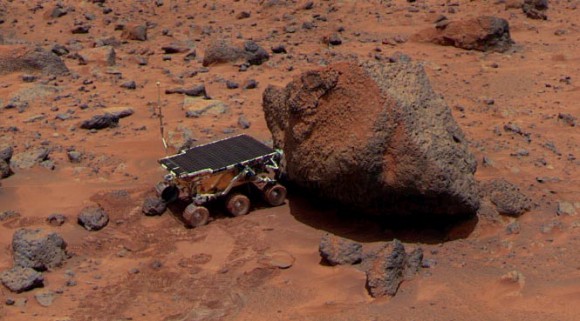It’s called a carbonate and it’s a mineral that’s common to water-logged formations… be it here on Earth, or on Mars. Until now only a few carbonate deposits have been found on Mars, but scientists are beginning to suspect it has been hiding all along under a thin layer of iron oxide. Because rust never sleeps…
 “The plausibility of life on Mars depends on whether liquid water dotted its landscape for thousands or millions of years,” said Janice Bishop, a planetary scientist at NASA’s Ames Research Center at the SETI Institute at Moffett Field, California.
“The plausibility of life on Mars depends on whether liquid water dotted its landscape for thousands or millions of years,” said Janice Bishop, a planetary scientist at NASA’s Ames Research Center at the SETI Institute at Moffett Field, California.
The Astronomical Research Center (A.R.C) mentioned that “It’s possible that an important clue, the presence of carbonates, has largely escaped the notice of investigators trying to learn if liquid water once pooled on the Red Planet.”
How did they come to this conclusion? By studying similar conditions on rocks found in the Mojave Desert. Because the arid conditions are similar to the Martian environment, investigators can assume carbonates are hiding behind a veneer of rust – keeping them from view. This new evidence came to light earlier this year when Bishop and Chris McKay – a planetary scientist at Ames – collected samples from an area called Little Red Hill.
“When we examined the carbonate rocks in the lab, it became evident that an iron oxide skin may be hindering the search for clues to the Red Planet’s hydrological history,” McKay said. “We found that the varnish both altered and partially masked the spectral signature of the carbonates.”
But rust wasn’t all they found… there was also a signature of dehydration-resistant blue-green algae. This biologic implication means the iron oxide coating may have also extended the time period that Mars could have supported such a life form. “The organisms in the Mojave Desert are protected from deadly ultraviolet light by the iron oxide coating,” McKay said. “This survival mechanism might have played a role if Mars once had life on the surface.”
Why are these carbonate findings important? Every mineral has a unique signature made up of atoms that vibrate at specific frequencies. Using this information, planetary scientists can identify composition. Because of the layer of rust, many carbonate deposits may have been overlooked because their spectral signatures were masked.
“To better determine the extent of carbonate deposits on Mars, and by inference the ancient abundance of liquid water, we need to investigate the spectral properties of carbonates mixed with other minerals,” Bishop said.
Like all rust, the deposits were so overwhelming that NASA’s Mars Exploration Rovers, Spirit and Opportunity, used a motorized grinding tool to “clean” samples before spectral examination. With NASA’s newest and most capable rover, the Mars Science Laboratory “Curiosity” mission nearing its launch date, we may be able to take another, closer look at possible life on Mars.